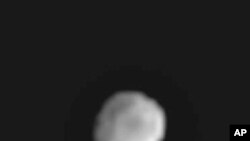NASA’s Dawn spacecraft has sent U.S. space agency scientists tantalizing new images of the mysterious protoplanet Vesta, one month before the unmanned probe is scheduled to arrive at the asteroid-belt object to begin its one-year scientific mission.
The 20 new images revealed a shining outline of Vesta’s jagged, irregular shape, as well as a large unidentified dark feature on its surface that astronomers estimate is 100 kilometers across.
Scientists believe that unraveling Vesta’s many mysteries will provide a kind of “snapshot” of the early Earth’s formation more than four billion years ago. That is because Vesta is largely unchanged since that time, whereas the Earth has evolved dramatically through the ages.
With a diameter of 525 kilometers, Vesta is the second-largest object in the main asteroid belt, a gathering of rocky space debris between the orbits of Mars and Jupiter. The giant rock's highly-reflective surface makes it the belt's brightest.
The Dawn spacecraft is expected to arrive at Vesta on July 16 following a nearly four-year voyage. It will spend a year mapping its surface, taking high-resolution images and collecting other data.
NASA calls Vesta a “protoplanet” because it is too small to be called a regular planet or dwarf planet, yet it orbits the Sun just like a planet, and it appears to share several key geological features, such as a molten core and mantle, with the four rocky inner planets: Mercury, Venus, Earth and Mars.
When Dawn's Vesta mission is complete, the little robotic probe will head for an unprecedented second orbital rendezvous in 2015 with the main belt's largest object, the dwarf planet Cerres, which is almost 975 kilometers wide.
New Vesta Images Dazzle Ahead of NASA Probe's Arrival










